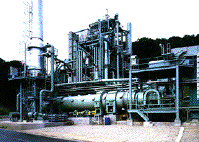 Science & Technology || Search || Back Numbers YEARNING TO BREATHE FREE:
 Companies expect a growing market for equipment to reduce dioxin emissions. (Photo: Mitsui Engineering and Shipbuidling Co.) The Japanese government will impose legal restrictions on the emission of dioxin, a toxic substance, from December of this year. Numerical standards of control will be set for urban garbage incinerators, industrial waste incinerators, and electric furnaces used in the manufacture of steel, with the aim of reducing total emissions by 90% in five years. In response, business circles are adopting various measures to control the emission of dioxin, and some companies see a business chance here. Punishment for Violating the Rules In August of this year the government revised administrative ordinances for the Air Pollution Control Law and the Waste Management and Public Cleansing Law in order to control the emission of dioxin from waste incinerators and electric furnaces used in the manufacture of steel. The revisions, which will go into force in December, will expand the number of targeted facilities from the present 5,000 or so to about 12,000. As well as setting numerical standards for each type of facility, the revisions impose various obligations, including the installation of cooling devices to keep the temperature of combustion gas below 200 degrees Celsius and high-performance exhaust gas disposal equipment to eliminate soot. The aim here is to control the emission of dioxin at the stage of occurrence. The legal regulations to be introduced in December include punishments, such as up to one year's imprisonment, for the violation of emission standards. In Japan, around 5,300 grams of dioxin are emitted into the atmosphere every year. By source, ordinary waste incinerators are thought to account for 4,300 grams, industrial waste incinerators for 700 grams, and electric furnaces and so on for about 300 grams. The Ministry of Health and Welfare expects that as a result of the legal regulations, the total amount of dioxin emitted from ordinary waste incinerators can be reduced by about 86% to 590 grams in five years and by 98% in 10 years. Europe and the United States made efforts to control the emission of dioxin ahead of Japan in the late 1980s and early 1990s. In Germany and the Netherlands, the limit on dioxin emission from incinerators is set at 0.1 nanograms per cubic meter of exhaust smoke (1 nanogram = one billionth of a gram). This regulation is much stricter than in Japan, where the limit for new incinerators ranges as high as 5 nanograms, depending on capacity. Promising New Recycling Systems Regarding new systems for the drastic curbing of dioxin emissions from incinerators, environmental equipment manufacturers and others are focusing their attention on the gasification dissolution furnace and the making of solid fuel from garbage. Already the construction of test furnaces has been getting underway. The gasification dissolution furnace involves burning waste, separating the combustible gas from the ash, and then further heating and solidifying the ash using this gas as the energy, thereby reducing the volume. Since the waste is completely burned, and the furnace is equipped with a device for purifying the emitted gas, the occurrence of dioxin is enormously curbed. The solid fuel system would reduce the number of places where waste is incinerated, and the solid fuel could be gathered in one place and used for power generation and other such purposes. The introduction of this solid fuel system would require several local governments to coordinate their plans to replace incinerators and construct power generation facilities, however, making cooperation among local governments and industrial waste businesses essential. Out with Incineration, In with New Technologies Stimulated by these moves, the Ministry of International Trade and Industry has also embarked on the development of technology to curb the emission of dioxin. MITI has commissioned an industrial group to investigate the mechanism by which dioxin is produced in electric furnaces and to develop technologies for reducing emission. Electric furnaces used in the manufacture of steel are made from scrap iron, which contains a chlorine compound. This chlorine compound is the cause of dioxin emissions. Based on the results of these investigations, MITI plans to build a prototype of a new electric furnace in fiscal 1998 and then move on to full implementation. Universities and other research institutes are also making active efforts in this area. The Faculty of Agriculture at Ehime University has discovered a microorganism that efficiently breaks up nearly 90% of quite high-density dioxin. Through cell fusion and other means, the university hopes to develop a high-capacity dioxin-breakup microorganism and make it available as a trump card for waste disposal from now on.  Edited by Japan Echo Inc. based on domestic Japanese news sources. Articles
presented here are offered for reference purposes and do not necessarily
represent the policy or views of the Japanese Government.
Edited by Japan Echo Inc. based on domestic Japanese news sources. Articles
presented here are offered for reference purposes and do not necessarily
represent the policy or views of the Japanese Government.
|
